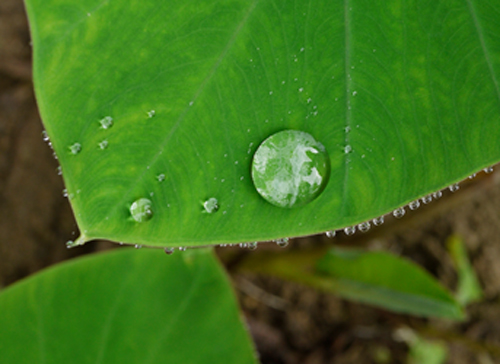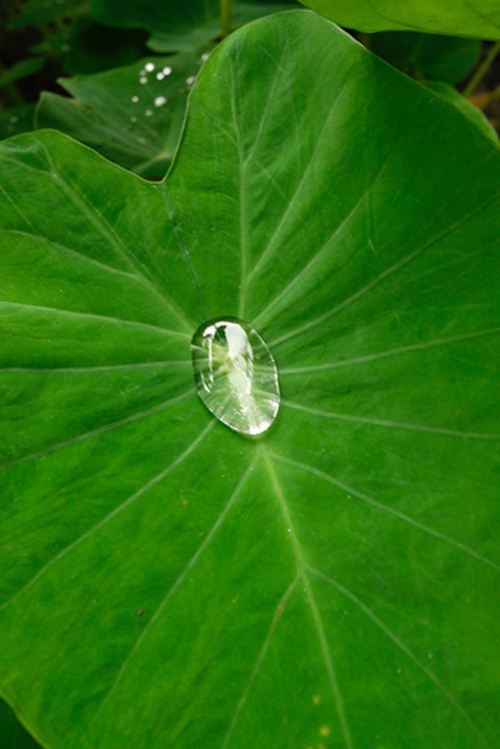巻頭コラム


- Taro (Colocasia esculenta, sato-imo) as a mirror of the world 2020年12月1日刊行
-
When people started eating taro in Asia, many thousands of years ago, they became more and more focused on easily-cooked varieties found in and around their gardens and settlements. Cultivated taros today represent just a small part of the diversity found in wild taro populations and closely-related wild species (Colocasia spp.). Wild taro populations have been found from India and China to Indonesia, Australia and New Guinea.
In gardens and settlements today, we can find taro varieties that grow well from tropical lowlands and mountains to the northern and southern temperate zones of the world. In tropical areas, cultivated and wild taros can flower, breed, and create new local varieties. Although taro does not breed in Japan, many different varieties have been brought here from other parts of Asia, over hundreds or thousands of years.
When people discovered wild taros with better qualities for cooking and eating, they started planting and growing them, and their attention became focused on the cultivated plants. Natural, wild taros were left behind. Wild taros do not produce much starch, and can be very itchy, even after cooking. The itchy substance is an enzyme attached to thin, sharp crystals (calcium oxalate) that enter the skin inside our mouth and throat.
Although cultivated taros are still itchy, the enzyme that causes itchiness is destroyed by cooking. In different cultivated taros, different parts are best for eating, depending on how easy to cook they are. After boiling, roasting, or frying, the main parts eaten are the leaf blade (happa), leaf stem (zuiki), starch-filled mother corm (oya-imo), and side-shoots. The side-shoot can be a starchy child corm (ko-imo), short starchy stolon, or long green stolon (tsuru). The long stolon is a good green vegetable that is popular in many countries, but not in Japan.
Some taros are best for growing in warmer, wetter areas like southwestern Japan, and some are best for growing in cooler, drier areas like northeastern Japan. Farmers always care about how well the plants grow, how much they produce (yield), and how well they resist disease, or attack by hungry insects, birds, monkeys, and wild pigs.
Today, taro is a plant that protects itself and that can be eaten in many different ways. Over thousands of years, taro became a truly global crop, found in Africa, Asia, America, southern Europe, and islands of the Indian, Pacific and Atlantic oceans. The strength, diversity and flexibility of taro is a kind of mirror of the world and human life. Because it is found in so many different places and cultures, there are also countless ways of cooking taro. Enjoy!
Ahmed, I., P. J. Lockhart, E. M.G. Agoo, K. W. Naing, V. D. Nguyen, D. K. Medhi, and P. J. Matthews (2020) Evolutionary origins of taro (Colocasia esculenta) in Southeast Asia. Ecology and Evolution. DOI: 10.1002/ece3.6958.
Matthews, P. J. and M. Ghanem (2020 in press) Perception gaps that may explain the status of taro (Colocasia esculenta) as an “orphan crop”. Plants, People, Planet. DOI:10.1002/ppp3.10155.
Prebble, M., P. J. Matthews, and 12 others (2019) Early tropical crop production in marginal subtropical and temperate Polynesia. Proceedings of the National Academy of Sciences. www.pnas.org/cgi/doi/10.1073/pnas.1821732116.
サトイモ(学名:Colocasia esculenta 、英語名:taro)――― 世界をうつす鏡
今から数千年前のアジアで、人類は自然界に自生するサトイモを食べ始めた。そして、次第に集落内の空き地やその周辺で、より調理しやすい性質を持つものに注目するようになった。現在の栽培サトイモは、その祖先の野生サトイモや近縁の野生種(Colocasia spp.)にみられる多様性のほんの一部を表しているに過ぎない。野生サトイモの自生群は、インド、中国から、インドネシア、オーストラリア、ニューギニアにかけて見いだされる。
現在、世界の熱帯の低地や山地において、また温帯においてよく育つさまざまな栽培サトイモの品種が知られている。熱帯では、野生サトイモも栽培サトイモも開花し、交配し、新しい品種を生み出すことがある。日本ではサトイモの交配は起こらないが、数百年、数千年をかけてアジアの各地から多くの栽培品種が導入されてきた。
人々は野生サトイモから調理しやすくおいしいものを見つけると、それを植えて育てるようになった。以来、人々は栽培される植物だけに注目するようになり、自然の中の野生サトイモは忘れ去られた。野生サトイモはデンプンの生産量が少なく、調理したあとでさえたいへんな蘞味(えぐみ)が残る。この蘞味はシュウ酸カルシウムの針状結晶に付着した酵素によるものだ。栽培サトイモにもこの蘞味はあるが、そのもととなる酵素は調理することにより破壊できる。栽培サトイモのどの部位を食べるかは調理のしやすさにより決まる。茹でる、焼く、揚げるといった加熱調理を経て、葉身(葉)、葉柄(ずいき)、デンプンたっぷりの親芋、子芋、そしてデンプンを含んだ短い匍匐枝(つる)や、緑色の長い匍匐枝などが食べられる。長い匍匐枝は日本では食べないが、多くの国々で緑色野菜として人気がある。
西南日本のように温暖で湿潤な気候でよく育つ品種もあれば、東北日本のように冷涼な気候でよく育つ品種もある。農家の人々は常に、いかに作物を良好に育てるか、いかに収量をあげるか、いかに病害や虫害に耐え、鳥やサル、イノシシの食害から守れるかを考えている。
サトイモは蘞味によって身を守る植物であり、さまざまな方法によって食べられている。何千年の歴史を経て、サトイモは今や、アフリカ、アジア、アメリカ、ヨーロッパ南部、インド洋、太平洋、大西洋の島々に見られる、まさにグローバルな作物となった。サトイモの持つ強靱さ、多様性、柔軟性は、世界と人々の暮らしをうつし出す一種の鏡である。なぜなら、サトイモは実にたくさんの異なる場所、文化において見いだされ、数え切れないほどのサトイモの料理法があるからだ。さあ、召し上がれ!
ピーター J. マシウス MATTHEWS, Peter J.(国立民族学博物館教授)
◆関連写真


Water on taro leaves (photos by author))
